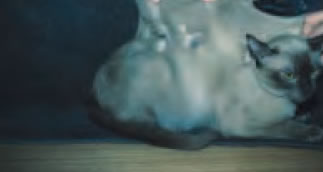Kitten Skin
Kitten skin problems are either unique to kittens or seen in both kittens and adult cats.
A newborn kitten should have skin that is warm to the touch and pink in color. If you pinch it, it should move right back in place.
If your kitten appears to be cold, unresponsive to touch or doesn't want to nurse, then you should be concerned and visit the veterinarian.
The best way to check kitten skin is when you are
grooming her. Groom her with a fine-tooth comb, and look at her skin
for symptoms of kitten skin problems as described below.
Common Kitten Skin Problems
Look for red patches, lumps or bumps, scaly patches or scabs, or flaky skin (it may look like dandruff), often on the abdomen or stomach. Sores can possibly contain pus. Also notice how her coat looks; is it dull looking, or is she losing any hair? You may also notice her scratching or licking herself more than usual. These are all signs of kitten skin problems, and indications that you should take your kitten to the vet.
One cause could be unsanitary conditions in the
litter box. You can clean the skin with a wash made for kittens (such
as diluted hydrogen peroxide or chlorhexidine and surgical soap). A
Triple Antibiotic Ointment or Neomycin should then be
applied. If there is infection your veterinarian may alos prescribe an
oral antibiotic.
Diagnosing and Treating Kitten Skin
Problems
You vet may be able to diagnosis a kitten skin problem just by looking at your kitten’s skin. In other cases, special tests may be required. There are a number of conditions that might be causing your kitten’s problem.
Fleas and Skin Problems in Kittens
Your kitten might have fleas which can results in several symptoms:
- Itch
- Scratching
- Hair loss
- Skin Damage
- Small Red bumps (caused by allergy to flea saliva)
- Lethargic Behavior
- Look of undernourishment
- Anemia (low red blood cell count)
Many flea products cannot be used on kittens that
are under 6 weeks of age. Be sure to check the label If she has fleas,
the fleas can be removed with the use of a mild shampoo labeled kitten
safe. Several bathes may be needed to eliminate all of the fleas. a
flea treatment will be applied. In addition, medication for the itching
can be given.
You also have to make sure that fleas are removed from the areas where your kitten lives. Throw out what you can and wash everything else. Consider using an indoor flea removal product such as Benzarid.
Allergies and Problem Kitten Skin
Your kitten could be allergic to something in the
environment, like dust or mold or pollen. She can be given medication
for this. In severe cases, she may need allergy tests to determine
exactly what she is allergic to and shots to desensitize her to the
substance. She might also have food allergies. In this case, she can be
fed a special hypo-allergenic diet.
Fungal infection- Your kitten could have a fungal
infection like ringworm. This is not actually caused by a worm, but is
named for its circular appearance on the skin. It is treated with both
oral and topical medication.
Bacterial infection- Your kitten may have a
bacterial infection, especially if she has scratched herself a lot.
This will be treated with antibiotics.
You will need to discourage your kitten from scratching and licking herself while her skin problem clears up.
Kitten Dirty Face Syndrome
Persian and Himalayan kittens sometimes have a skin condition on the face (facial dermatoses). Symptoms of this condition include:
- Inflammation around the mouth
- Black spots on the skin
There is no treatment for this condition. Ointments for the face tend
to provide temporary relief.
Ehlers Danlos Syndrome (Cutaneous asthenia,
dermatosparaxis)
In this condition, the kitten skin will appear to be fragile, soft and easy to pull, as if there is excess skin. Your kitten will easily injure the skin and cause tears in the surface with little bleeding. When the skin heals scars will remain.
Eye problems may also appear including cataracts
(cloudy appearance to the eye). Diagnosis of this condition is done via
an examination in your veterinarian's office and by taking a skin
sample (biopsy) and then examining it under an electron microscope
(called a Masson trichrome stain test).

Picture of Kitten Skin dermatosparaxis
Natural Remedies for Problem Skin in Kittens
There are several herbs, nutrients and tissue salts that are known to support the skin and coat including:
- Equisetum arvense (Horsetail) contains silica which is essential in the maintenance of healthy and strong skin, bones, claws, and fur.
- Taraxacum officinalis (Dandelion) a source of vitamins and minerals, including Vitamin A, D, C, various B Vitamins, iron, lecithin, silicon, potassium, magnesium, zinc and manganese.
- Arthrospira platenis (Spirulina) a source of chlorophyll that contains protein, vitamins (including B12 and folic acid) and carotenoids.
- Fucus vesiculosis concentrated source of minerals, including iodine, potassium, magnesium, calcium, and iron.Regular use supports skin and coat condition.
- Kalium sulphate (Kali. Sulph.) is a biochemic tissue salt that helps to maintain health and balance in the skin and underlying tissue.
One product worth researching that combines all of these ingredients is PetAlive Skin and Coat Tonic for Healthy Skin in Cats. As with all prescription and natural options, discuss this approach with your veterinarian so that he or she can track progress.
Sources:
Carter, G.R., Wise, D.J., and Flores, E.F. (Eds)
A Concise Review of Veterinary Virology
Advances in Puppy & Kitten Health Care
Iams Clinical Nutrition Symposium 2005
Seville, Spain
From Kitten Skin
More on Cat Skin Problems
To Cat Health Guide Home